
All Our Selves In One Basket
Published 2020-09-02
All Our Selves Stuck In One Basket
There's a classic old idiom, "don't put your eggs all in one basket". The reasoning goes, what if the basket breaks? What if the basket isn't big enough, or gets stolen, or was cursed by a witch or something? It's important to have redundancy, to spread the eggs across many basket so that there's no one single point of failure.
But if we look at society, if we look at the internet, if we look at the communities we've built ourselves around... unfortunately, I believe that's exactly what a lot of us are doing. Being able to be yourself, being able to choose how you present yourself to the world, being able to tailor your living environment to your needs and desires? That's all very, very important. But if you give the keys to your self-expression and the options for the communities you belong in to one small, largely unknown group of people, that's not good.
In this ludicrously in-depth article, we'll be discussing how society limits both individual and community self-expression both online and offline.
Part 1: The Third Place
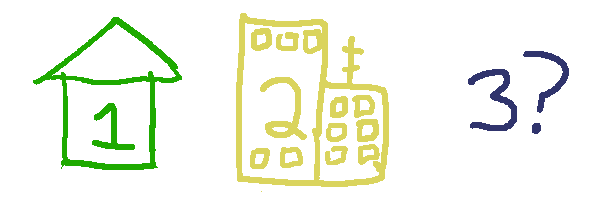
Very, very broadly speaking, a working-class person (that is, not an "owner" like a CEO, landlord, or investment banker) lives their life in three kinds of places. The first place is home. It's where you sleep, it's where you do your hobbies, it's where you have privacy and family and possibly friends if you want to invite them over. The second place is work, where you do a job to contribute to society and receive wages.
But clearly, we do more than that. We go to other places. Grocery stores and shops, of course, but besides that. The "third place" is where you spend your time in public, in your community. American urban sociologist Ray Oldenburg, who came up with the concept of "the third place" in his 1989 book "The Great Good Place", defines the third place as (commonly seen as) eight characteristics.
- There is no obligation to be here for legal, survival, political, etc. reasons. You can just not show up.
- Everyone is equal. The rich, the poor, the minorities and the majorities all intermingle together in one common space.
- Conversation and socializing is the main activity. You go here to "hang out".
- They're accessible and accommodating for anyone who wants to visit.
- It's a place where people regularly go, and whose regulars give the space its vibe and characteristics.
- The physical place is not overly pretentious or imposed. It feels like the community, like an extension of home.
- Generally speaking, the vibe here is more calm and friendly and playful than actively hostile and argumentative.
- You feel like you have genuine ownership in the place, as if it's almost a communal home for you and the people you care about.
That's a relatively high bar, when spelled out like that. In pandemic-era America you'd be very hard pressed to name a place like this. Offline, anyways. But this sort of pattern has shown up a lot in history, because as it turns out people like having a communal space to just vibe in.
The Town Square

The most obvious example in urban environments is the town square or the plaza. It's an open area in the middle of town, usually with benches and close access to shops and homes and such. Pictured is La Plaza del Zócalo, the main square of Mexico City. It's been a meeting spot for the people of the area since the Aztec times, an important location for numerous historical events, and significant enough to warrant its own Wikipedia page. That's really amazing for a 240 m^2 slab of concrete. What's even more amazing is that it wasn't always a slab of concrete. Here's a model of how it looked in 1910.
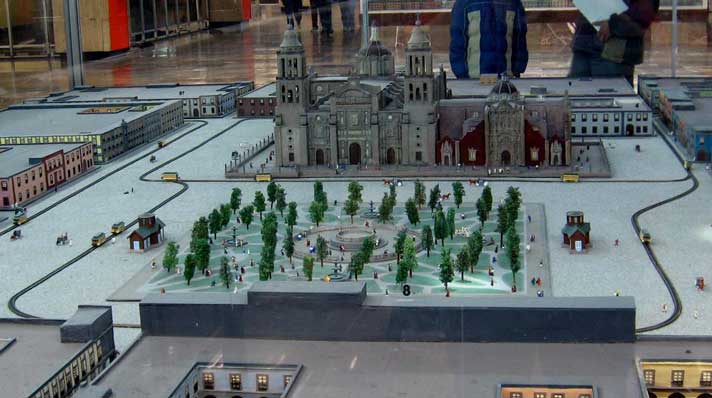
It was a big park area! With a bunch of trees and benches and everything. Unfortunately, the very shaky politics of 20th century Mexico left the area in major disrepair by the 1970s, and it became that. I am not from Mexico, nor do I know anyone from the region, so I can't comment on what that did to the community in Mexico City. But as an outsider, I'd consider the 1910 Zócalo much more friendly and inviting than the modern one, which is literally a flat surface with a flagpole in the middle all surrounded by a busy road.
Obviously that isn't the only example. These tend to be a staple of small European and Hispanic towns. Just, a place, in your neighborhood, to go and chill. Other famous examples include the Roman Forum, the Greek Agoras, the National Mall of Washington D.C, and the "quads" or "diags" of most college campuses.
Shopping Malls
It is incredibly worth pointing out that town squares only make sense in urban contexts, where there's a dense population of people who live, work, and shop in one general area. The appeal of town squares is that they're basically on the way to wherever you're going, so it's a really nice spot to meet up with friends or just go if you're bored.
Suburbia is not that. Or, more accurately, it is that, at the scale of the car. See, America's fascination of suburban sprawl has a long detailed history to it. Paraphrasing from (imo) a very good book, "Repairing the American Metropolis: Common Place Revisited" by Douglas S. Kelbaugh, the blame of sprawl can be pinned down largely on cultural reasons. First off, Americans always solved their resource and land division issues by expansion, growth, "moving out west". It was the safety valve to avoid actually thinking about difficult problems. At the time this was seen as the country's "manifest destiny", which eventually led to unnervingly cheery songs on children's television happily glossing over the genocide of Native Americans like it was no big deal. And, heck, if we got all this elbow room, why not make everything really, really big? Big houses, big rooms, big parcels of land. And really, really cheap too, because of the glutton of natural resources. And sure, that'll get old and worn sometime, but some of the population will leave for greener pastures anyways, so there's no need to change anything.
So, around the early-to-mid 20th century, when cities were getting too full of colored people who were just demanding rights too loudly, most of the rich white people just up and left. They settled suburban areas outside the cities, less densely populated, with all the backyard space you need to cook out with your neighbors. And via redlining, it was possible to dig very deeply a concrete "us vs. them" line in the dirt. The newfangled highway system just made it easier to separate the houses from the factories, to drive a wedge in the population. Also, just to drive the point home, federal, state, and local governments have subsidized services like sewer pipe connections, energy, and road building, often funded by taxes generated from the more urban, more productive areas.
An incredibly good example of this is to compare Flint and Burton, MI to the surrounding cities of Grand Blanc, Flushing, and Davison. I could spend a lot of time on this but I'd rather just do a visual comparison.
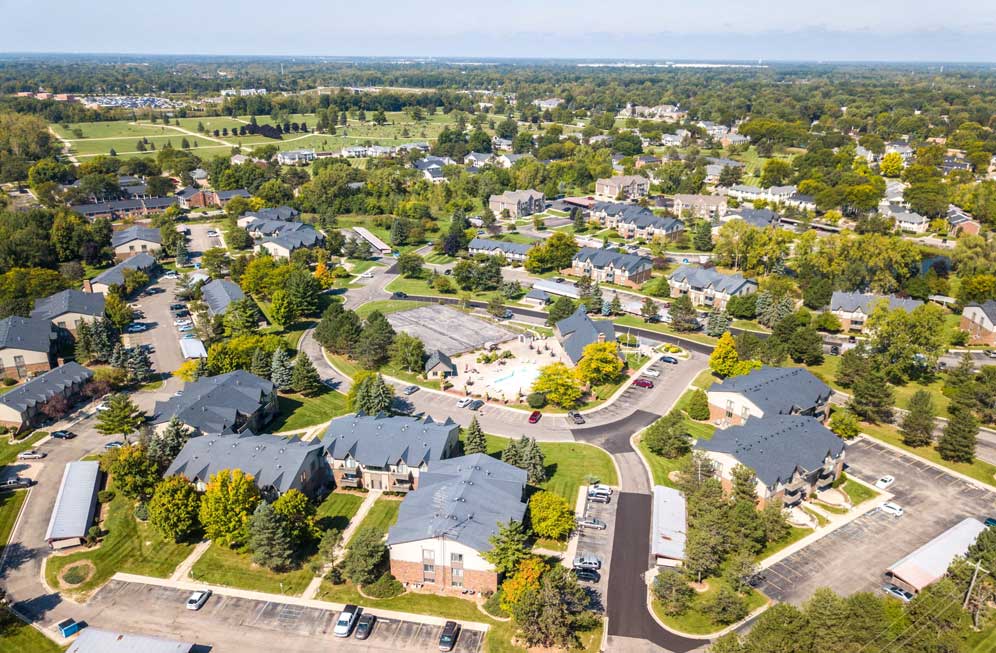
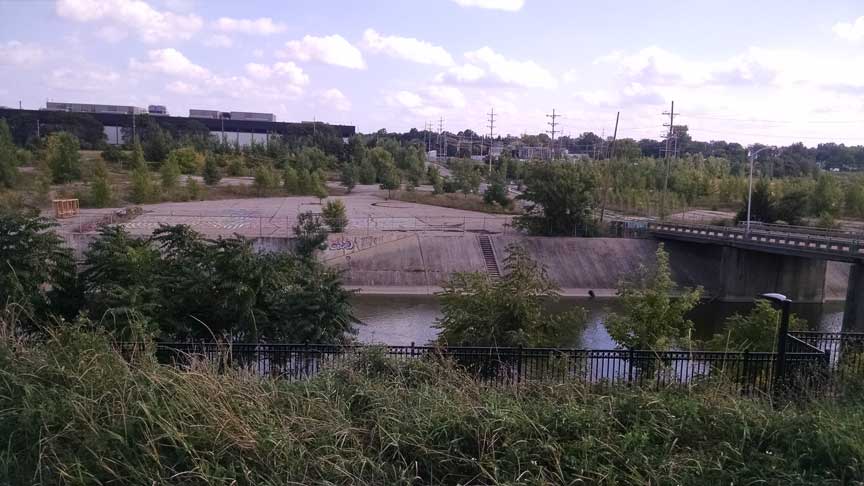
It should be laughably easy to tell which one is which. (The first pic is the Fox Hill Glens of Grand Blanc, which was the first image Google gave me. The second pic is a section of the Flint River between downtown Flint and Kettering University. I took that pic during an urbex tour a few years back, because Flint was somewhat nearby and makes for amazing urbex pics.)
Where this starts to cause issues is that instead of having one core neighborhood with residential, commercial, and industrial areas (in a SimCity-esque model), we've split those sections into their own, largely independent areas, often harshly split on racial or class boundaries. We've got gigantic swaths of houses with maybe a corner store and a gas station, we've got giant industrial parks or office complexes, and we've got the commercial districts.
It's the commercial districts I really want to highlight here. If the residential areas are home, and the industrial/office parks are work, then clearly the third place is the commercial district. Now, there's two ways to approach that.
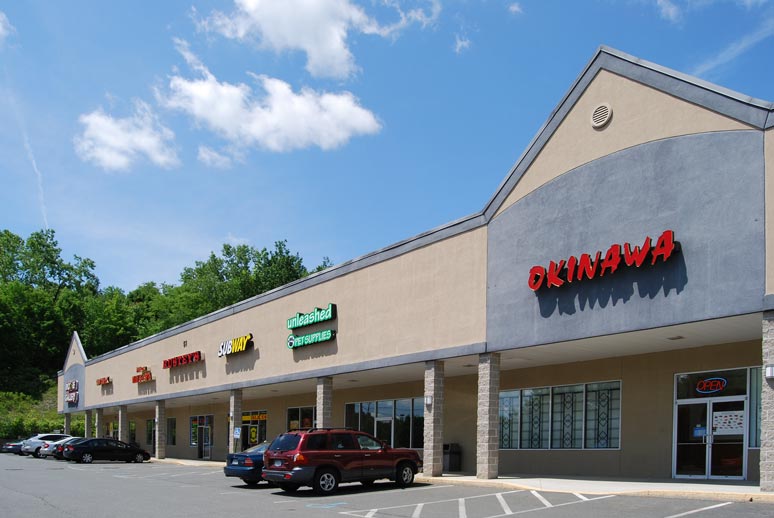
The most common approach is to just put a bunch of boxes next to each other, surround it with a parking lot, and call it "a strip mall". Occasionally there will also be a "big box" store, like a Wal-Mart or a Target or a Best Buy or a Kohl's or a Home Depot, either attached or detached.
In the very worst scenarios, you're subject to drive through the "stroad", or street-road, where all the shops each have their own driveway and their own parking space and it's hostile to both people and cars.
You drive here (or take the bus, if you're poor and you're fine with the once-an-hour service), you shop, you drive home. You don't really spend time here. There is literally nothing here besides concrete boxes. And also the constant issue of cars driving past you. Hope you like sprinting across five lanes of traffic moving at 40 mph!
Enter Austrian-born architect Victor Gruen. After fleeing to America from the Nazis, on account of being a Jewish socialist, he slowly worked up the career ladder, from draftsman to architect. And he absolutely saw the issues of suburban sprawl. In the 1950s he gave a speech where he called the suburbs "avenues of horror ... flanked by the greatest collection of vulgarity ... ever collected by mankind."

As an alternative, he envisioned a single building, a few shops surrounded by a shared courtyard, protected from the weather. Something of an iteration of the old "arcades", like the Strand Arcade in Sydney, Australia as pictured above. The courtyard was the most substantial improvement, it was somewhere to go in between shopping. The arcade was just a straight hallway normally, literally just shops in a building. The shopping mall was a destination.
Victor has larger goals in mind. He expected this to be just one part of a new, dense, suburban community. He imagined indoor malls with housing, with schools and libraries and doctor's offices and offices, perhaps surrounded outside by high density housing or other needs. Unfortunately, the concept of an indoor building with a bunch of shops that you could just chill out in became very appealing to fill in the gaps left by suburbanization.
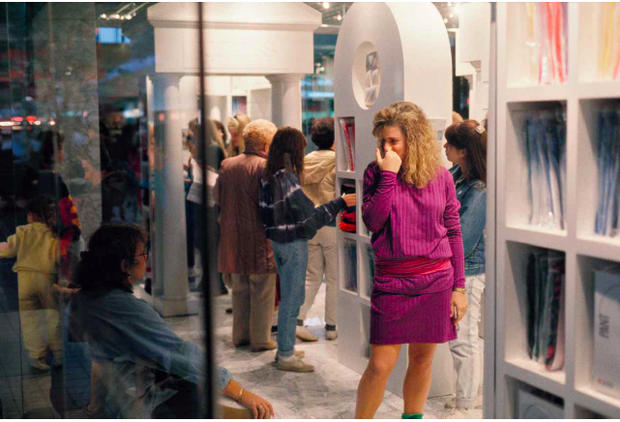
But, despite that, people did go to the mall. It was a common cliché that teenagers would all go to the mall with their friends to buy clothes, eat at the food court, maybe play one of those new-fangled video game thingies, etc. etc. There's a good photo collection from the 1980s by Michael Galinsky, some of which you can see here, showing just how lively and active malls were in their heyday.
(More about the history of shopping malls here, if you want to read more.)
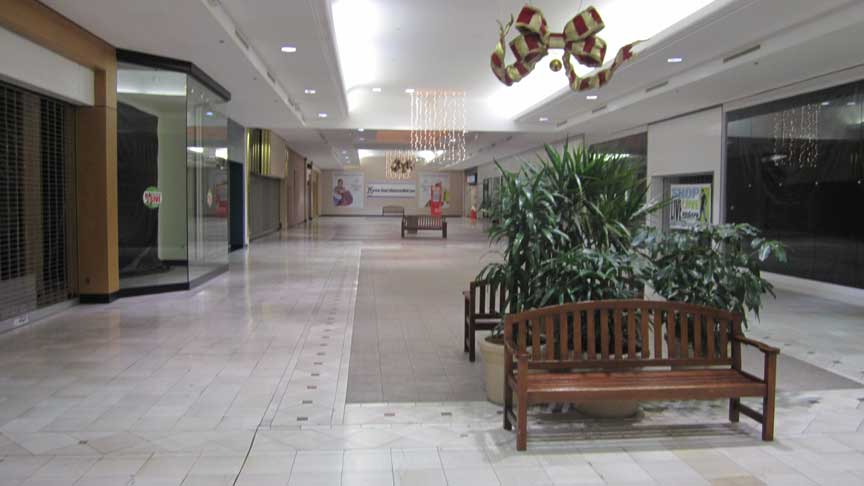
That said, since the 80s we've had the rise of credit card debt, student loans, the housing crisis, the 2008 recession, the dot-com boom, online shopping, and now COVID-19. The thing about shopping malls is that they're really not all that fun to go to if you don't have money. What are you going to do, go window shopping every weekend?
Rarely were places like grocery stores, let alone any other community staples, located in or around malls. At least for me growing up, they were always the super far away thing we'd go to maybe a few times a year. It's a way to spend a day, but it stopped being a hang-out spot and just became, well, an arcade. A collection of shops under a roof, with a food court if you get hungry and a bench if you need it.
So, I think it's very safe to say that malls are no longer the "third place" where everyone goes to. But that leaves a rather scary question. What even is the third place in a suburban area where it's just... houses? Forever?
Church

(Image from The Toledo Blade)
Churches, ignoring the religious aspect, are buildings where you and your community go to at least once a week. The nature of sermons and such tends to encourage emotional connections, and it's a very good icebreaker to get to know the people in your community. And often times churches hold non-religious services too, like picnics or free community lunches or the such. By every respect, these were the pin that held together suburban communities. Church was what built and strengthened the community.
Of course, of course, restrictions apply. You'd be very hard pressed to enjoy or even be welcomed in church if you were not Christian. Heck, even the Catholics and the Protestants and the Mormons and all the rest couldn't get along with each other enough to share one church. And I doubt you'd have a good time in 20th century American churches if you were non-white, or LGBT, or were Deaf, or were too left-leaning politically, or any number of other things. In that case, you did not belong in church. Maybe there would be enough of you to form your own, independent church, but probably not. And besides, that doesn't solve the issue of the divisions drawn through the neighborhood by these actions.
Recall three important points about "third places". They're accessible / open to all, they're places you socialize, and everyone is equal. Churches violate all of those. And I'm not knocking the concept of church by any means, but it feels very absurd that they're often the only place where large portions of the community go to, that anyone could feasibly drop in at, and that don't involve traveling long distances to spend money.
Well, there's one more ace up the sleeve for suburbia yet.
Libraries
Libraries are underappreciated, in my opinion. They and parks are about the only places you can go in society without the expectation of spending money. Libraries are, broadly, places that connect people to information. Historically that has been via books, because they're information-dense and easy to reproduce, but libraries are more than that. Librarians, for instance, can and do often help the community by doing research, directing people towards resources, and sometimes even teaching community classes.
Some libraries are realizing their special place in society by catering to this demand for a "third place". Most libraries by now loan out movies, music, audiobooks, and video games. (On that note, if you're done with one of those, definitely consider donating it to the library, so it can be loved and cherished by many, and not just collect dust on your shelf or get $5 at GameStop.) Most also provide computer labs as well, free of charge.
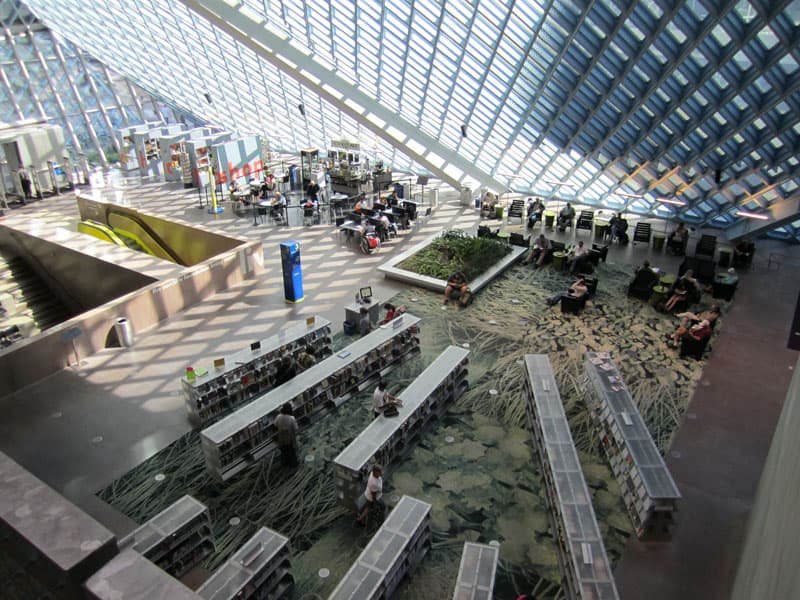
(Pictured: Seattle Public Library)
But that's just adapting to new forms of information. Some libraries have upped the ante past that. We're starting to see libraries with coffee shops, or couches to hang out on, movie theatres and 3D printers and all sorts of fun new stuff. The vibe has moved far from the "boring place ruled by an elderly lady who hates noise" stereotype. I like the trends being made here. I like the idea of a community space to just chill in, and spend time with people with. Plus, libraries already are in just about every community.
But there is an issue here, unfortunately: Politics. Libraries are, inherently, a single building (or various branches) whose employees are funded by taxes. This isn't just an open park area where you can just sit down; it won't maintain itself with a single janitor. Libraries need to provide a lot of services, and placing all of that at the mercy of the local city government can be a big ask. I definitely think that libraries should provide new and attractive services... but I think it's unfair for them to hold the burden of supporting an entire community's social and informational needs. Whoever controls the library would control the primary space of the community.
Keys to Power

And that's a very interesting point. Whoever controls the third place controls the community. If the third place is a building, and they decide to renovate, tough luck. It's being renovated. The third place is where the community lives, it's where they go by default essentially. If you own that place, you own a considerable amount of power in the community.
Slightly more devilishly, let's consider the mall again. If the mall is the third place, the community center, where almost everyone goes to... oh my gosh would that be fantastic for business! Imagine, thousands of people under one roof, being bombarded by advertisements from all angles, being enamored by the smells of the food court, that would be so profitable.
Now, in a perfect textbook capitalist society, that would be fantastic. The mall would adapt as needed to suit the demands of the cust-, er, community changing. However, we often find that changes tend to be enforced from the supply side instead. Nobody votes on whether an item should be discontinued, or which store should move into a mall, or what sorts of plants the courtyards should have. That's determined exclusively by money. Whoever bids the highest moves in, whatever makes the most profit stays in stores (even if unethical), whatever plants the psychologists at corporate or the architect in New York thinks shoppers like most are the plants you get. You cannot boycott a potted plant and expect it to change.
Churches are a little bit better, in the sense that they (hopefully!) don't have profit in mind. Churches exist to preach religion and form community bonds. But they do so while excluding anyone who doesn't agree with what the church teaches. Which is fine, if your choice of church is no more important than your choice of fast foot restauraunt. But if you give the keys of community organization to the church, you give them an incredible amount of power to shape the community in their own image. Hopefully for good. But there's that risk that they'll abuse that power for their own religious or political gains.
Another thing to point out about churches and malls: they're really big into dividing people up into groups. Malls have different stores for different people, and they tend to group stores targeting a similar audience together. (Or at least they could; I'll admit I don't feel like going through the trouble of backing this claim up.) If you shove the teens in one corner of the mall and the housewives in the other, you're making it that much less likely for teens and housewives to ever interact, let alone make meaningful connections. Churches do this by literally having different buildings run by different people, but the division is still there.
And, wouldn't you know it, there's one last third place I never mentioned. But I'll stick a pin in that for now.
Part 2: Self Expression
Real Life Sucks
Let's talk about my personal life, on the small scale. Let's talk about the room I live in, the clothes I wear, the passions I enjoy. Let's talk about how I'm able to express that IRL.
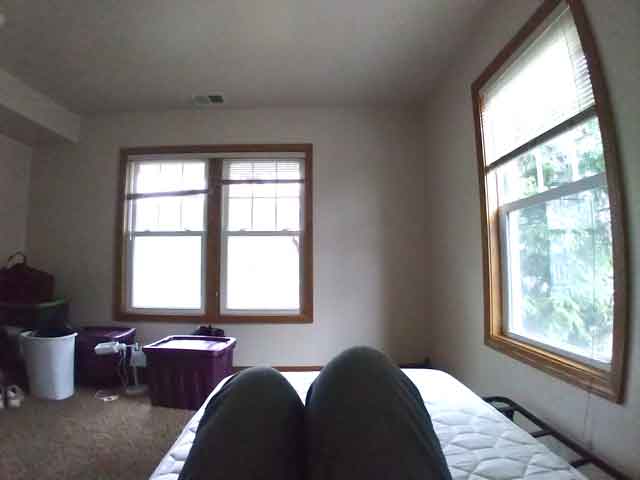
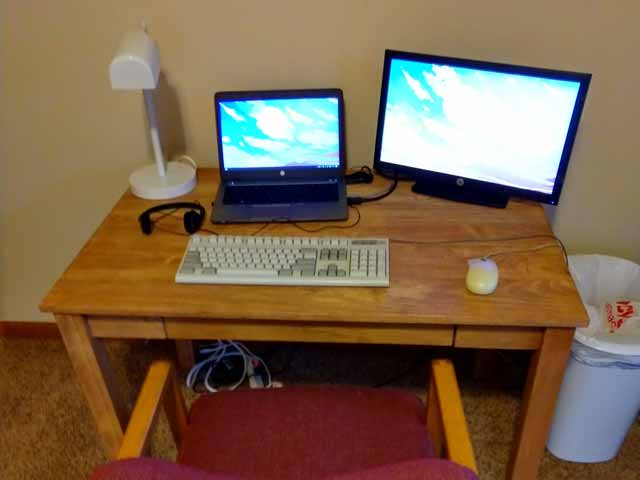
Oh wait, that's right, I'm practically a broke college student! Ahahahaha~! It's a miracle I have an income at all, and most of what I make goes to either rent or paying for college. I don't have the extra funds to go try out new clothing styles, or to deck out my room, or to have anything on my desk besides a laptop and a computer monitor. (For the sake of transparency, I've improved things a little since I took these pics a year ago.)
Okay, well, I do, but that's an anxiety-inducing gamble to make. What if I waste money on something I don't like, actually? What if I lose or break the things I buy? Where do I put the stuff I get? How do I transport it? How do I get rid of it? It's all, really, a lot.
I realize I just hit you with a lot there, so let me slow way down. Society, as it stands right now, has a contract: you work, you get money. You have money, you pay your bills, you spend the rest on whatever the heck you want. Wanna buy some nice, color-coordinated sheets for your bed? Go for it. Wanna paint your walls blue? Heck yeah. Posters? Lights? Bookshelves? Rugs? Lamps? Other room stuff? That's all fine, that's all reasonable, make your space your own, you earned it.
But, well, you might notice a bit of a glaring problem here if you've glanced at the news lately. (circa August 2020) Between mass evictions, unemployment numbers soaring, unemployment benefits ending, there's a lot of people lucky to have any place to sleep. They're certainly not worrying about new clothes, or matching curtains, they're just trying to find any job and find any place to sleep, take care of their children, take care of their own mental health, etc. According to the social contract, they haven't earned the right to self-expression if they haven't even earned the right to a stable place to live.
And, in my opinion, that's not good. We absolutely should not be tying things like "feeling comfortable in your own home" or "liking how you present yourself daily" to some strange notion of having "earned" the right to do so. But, unfortunately, we do. It costs money to express yourself. Money's hard to come by for poor people. But hey, they can have their dream space when they've earned enough to buy their first starter home, or whatever. (Not that starter homes are really a thing anymore, but that just means you need to pull on your bootstraps harder.)
But that also leaves a lot of people, struggling to get by, with almost no outlets to express who they are. I'm one of them. And, okay, "struggling" is a bit much, I'm honestly doing okay with finances. Just, not okay enough to feel confident enough to spend money on anything that isn't useful. So, instead, I turn myself to the one outlet I have for self-expression: the computer.
Personalize Your Desktop
It costs money to paint my walls, not that I even can considering I rent my room. It costs money to get a different desk, not that I even have a car to transport it in. But the computer? Right click, Personalize.
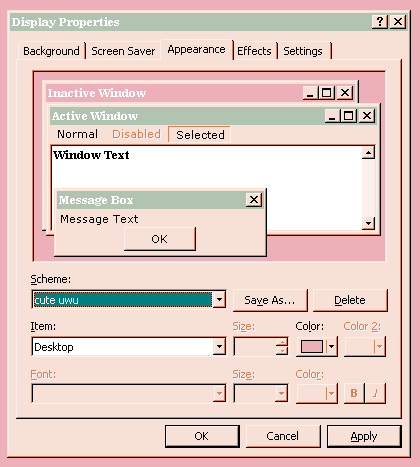
The computer is my space that I can decorate any way I want. I can change the wallpaper to be a nice outdoor scene, or my favorite characters hanging out, or just something that makes me happy. I can change the colors of all the windows to match my mood. I can rearrange all my files into folders, in a manner that makes sense to me. It sounds so little, but this is honestly so, so much more power over my environment than I have IRL. It's my computer, my personal computer.
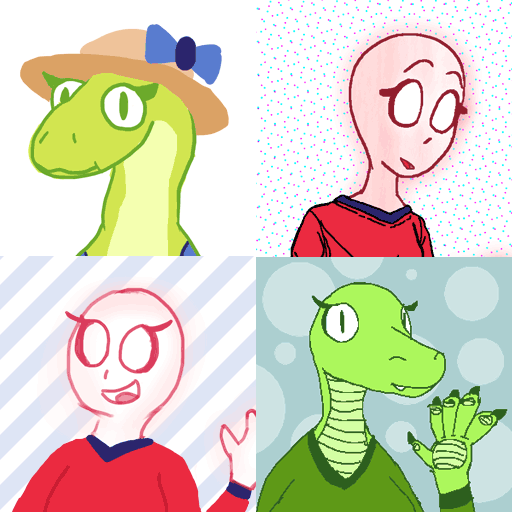
And when you add the internet to that? Oh heck yeah. I'm not limited to expressing myself with plain colored T-shirts I got in high school, or whatever I can find in a thrift store (after taking an hour long bus ride and sprinting across a five lane highway just to get to it, seriously). I can use my drawing tablet, or even my mouse, and draw myself however the heck I want. I can wear all sorts of cute clothes, I can play around with how I look, all for free. Heck, I don't even have to represent myself as a human if I don't want to. I can play around with my species, try out tails or different body parts or whatever the heck I want. And that's me, on the internet. Completely unrestrained. It's amazing, really.
Plus, also, this website? It's like my home, on the internet. I have this online, virtual space that I can decorate any which way I want. I can add all sorts of things for people to read, talk all day about the things that interest me, make it any color, any pattern, any font, any layout. I keep it simple, yes, but it's my space. And there's Park City, the "netgroup" I admin as well, which is like a communal webspace for me and my friends. It's just, I feel such a sense of ownership over my homepage, such a sense of freedom, and I love it.
If there's anything this pandemic has taught me, it's that I need this space to express myself. For the vast majority of the pandemic I essentialy did not have a life outside the digital world, besides the bare minimum like eating and sleeping and such. Most places outdoors right now are too dangerous, and I do not feel any sense of ownership at all in my current living space. The computer is all I have. It's all a lot of people right now have.
I want to again repeat that this really isn't good. I would love to just, have clothes that represent me, to have walls that aren't completely bare. Without the internet, I would feel trapped and miserable. The internet has often been my only outlet to the outside world, my only place to feel like anything but a victim of society. Yes, that's harsh. But really, it's true.
The problem is, it's becoming harder and harder for the average person to even have this. There's such a high skill ceiling to making a webpage, and personal computers are becoming increasingly impersonal.
Just like reality.
Gentrification
As a rough, "good enough" definition, we can say that "gentrification" is when a space that you previous felt great pride and ownership in becomes taken over or bought out by others to fulfill their needs instead. The obvious example is the gentrification of urban areas. I haven't really lived through this, so I asked my friend Roxie about her experiences. She grew up in the Bronx in NYC, before she later moved elsewhere.
Her life growing up was far from peaches and roses. Everyone around her grew up renting run down WWII-era apartments run by slumlords. There definitely was the us-versus-them mentality... but the "us" felt very connected to each other. Roxie and her community weren't necessarily super friendly and always saying "hi" to each other per se, but they had a strong community support network. They helped each other out when they needed things. People who made Puerto Rican or Dominican food in bulk sold it cheap to their neighbors, or just gave it away. It was far from perfect, but it was home.

As time went on, though, "it was home" felt less like a fact and more like fiction. A lot of the places she'd hang out at when she was younger would disappear over time, or be replaced with something worse but with a "broader appeal". The one example that stands out to her was this arcade, Chinatown Fair, which was a big hub for the fighting game community. Lots of tournaments were held there, lots of non-fighting games, it was generally just a fun place to be. They stayed open late, they had good food in the surrounding area, in general the atmosphere was just very welcoming. Here's a good blog post documenting what it looked like back in the day.
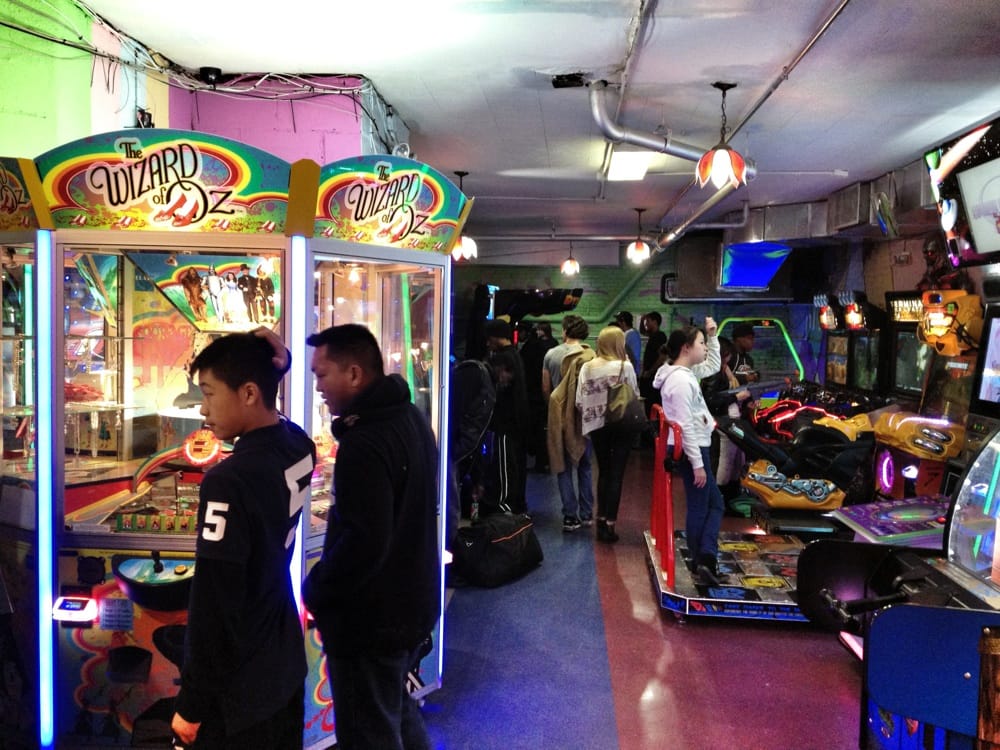
Then the landlord jacked up the rent. Chinatown Fair closed. The fighting game community worked around this, did their own thing, and they survived. Unfortunately, the rest of the community died out. Eventually the place reopened under new management, but all the games were replaced with the usual ticket/redemption games, maybe a DDR machine at best. It was sanitized, it was boring, it was profitable. But it wasn't home anymore. Home was taken from her, replaced with something prescribed by the higher-ups.
Alienated by the Town Square
There was this article I read, titled Why You Hate Contemporary Architecture, that does a really good job at describing this issue. There was no point in beauty, no point in decoration, as it was useless, distracting from the primary usage of the building, and a needless expense. Quoting the article,
Well, Peter Eisenman has spoken for a lot of architects in being generally dismissive of democracy, saying that the role of the architect is not to give people what they want, but what they should want if they were intelligent enough to have good taste. Eisenman says he prefers to work for right-wing clients, because “liberal views have never built anything of value,” due to their incessant concern with public process and public needs.
And really, this stems from the fact that buildings aren't designed by the community that uses them anymore. The community barely factors into the design, even. Buildings were designed to serve a specific purpose, dictated by the higher-ups with the money to purchase the land and fund the development of the building. Again, quoting the article,
Unless they are an uber-wealthy client, users of buildings rarely have much input into the design process. Students do not get to say what kind of school they would like, office workers do not get to say whether they would prefer to work in a glass tower or in a leafy complex of wifi-enabled wooden pagodas. ... But that rupture means that architecture becomes something imposed upon people. It isn’t participatory, and it doesn’t adapt in response to their needs. It’s prefabricated, assembled beforehand off-site and then dumped on the unwitting populace. We are not meant to live in modern buildings; they are made for people who do not poop.
And that's what happened to teenage Roxie's favorite arcade. The existing community was kicked out, replaced by something designed with absolutely no input from the community. It wasn't even the community's choice to kick the arcade out. There was no vote, there was no decision, there were no surveys. The people who control the neighborhood aren't the people who live there, the people who hang out and enjoy its offerings, but instead some higher-ups with money, making secret deals on golf courses miles away, only concerned about moving numbers around.
Gentrification, really, is the loss of ownership, the loss of community, in the places where you spend your time. Gentrification is the sense that you're no longer welcome as anything more than a cog in the machine.
Part 3: And So Falls the Internet
In that discussion we had, Roxie brought up the point that the internet is also becoming a victim of the same problems, the same loss of ownership. "Internet Gentrification", in a sense.

(Pictured: The Neocities index)
On a macro level, let's look at the concept of "homepages". Way back when it was almost expected that you'd have a Geocities page, or an Angelfire, or a Tripod, or a .mac homepage. Even if a lot of people never took up the offer, the option was at least there. You could very easily go to a bookstore and buy a book on "how to make your own website", and it was pretty easy, all things considered. Software packages like Microsoft FrontPage, Adobe GoLive, and Macromedia Dreamweaver made it very easy to have your own personal internet space.
Now, I'm not calling that the pinnacle of society. Things weren't great back then. There was no easy way to find new content besides trawling through the web of hyperlinks. Subscriptions or the concept of "the feed" had yet to be invented, for one. And IRC chatrooms, Usenet groups, etc. did exist (like Discord and Reddit today), but internet culture back then was pretty harsh, pretty rude, pretty unwelcoming a lot of the time. (Remember shock websites? I don't miss those days.)
Things began to change in the mid-00s with the rise of "Web 2.0" and "Application Programming Interfaces", or APIs. Tom Scott made a really good video about this titled This video has XX,XXX,XXX views, with the idea being that the number would constantly change so long as YouTube's API didn't break. (As of writing the number is 16,894,423. The first time I saw it on Discord back in April, the number was 140,344.)
Summarizing the video, the mid-00's was about when people realized that they could pipe around data, shape it, transform it. You could use data from Google Maps, from the weather service, from the up-and-coming online services like Twitter and YouTube, and have it all interact with each other. It was, at the time, a way of giving people ownership of their data in a way they never could before. IFTTT is an example of this; it was (and still is) a web service that lets you automatically do things when other things happen. For example, you could send a tweet whenever you updated your blog, or you could get an email when the International Space Station was about to fly overhead, or countless other combinations.
And, well, let's take that pin back out now. Let's talk about that last "third place". Social media sites.
A History of Social Media
Let's face it, these days, if you want to socialize, you don't go out to the mall or the library, and it's a 50/50 shot if you even have anything resembling a town square. You go on the internet.

And that's had its ups and downs. In the very early days (the 1980s), there were "bulletin board systems", which were often just someone's Apple II connected to a phone line. You'd dial in, leave a message or grab a file, then log off so the next person could take their turn. Eventually, some of these pooled together into larger networks like "Fidonet". With this, individual servers could "federate" with each other to produce a greater community, without compromising on the ability of local administrators to do their job.
On the more academic side, you had Usenet, which today I would best describe as "Reddit, powered by email". There were "groups" like comp.sys.apple2 like Reddit's subreddits, and they could be either moderated or unmoderated. You'd start a "thread" by sending essentially an email at the group, and you'd be able to view threads in your Usenet client. You could reply to a thread by sending a message in response to another message. It worked quite well for the time.
If you were lucky enough to have a live internet connection (instead of just having your messages delivered once a day or whenever), you could even participate in Internet Relay Chat. IRC worked quite a bit like the BBSes; you logged into a server that provided its own channels, and possibly federated with a greater network like EFNet or Freenode.

As the 90s played through, the tides started to change to become a little more centralized. Two key factors played into this: internet service providers and the World Wide Web. ISPs like AOL or CompuServe allowed you to access Usenet and IRC and any other Internet service, but they really wanted to sell you on their own "walled garden" of exclusive and finely curated offerings. I did a walkthrough a few years back on AOL's stuff, and plenty of YouTube videos showcase it in motion. But AOL was just one service provider. It had plenty of competition.
Outside of that, dial-in BBSes were starting to become impractical compared to just being on the Internet. And there was a need for a common document format that could "link" to other pages on other servers. And so the University of Minnesota came up with Gopher!

...but that had a large number of limitations and regrettable design flaws, so some dude named "Tim Berners Lee" made this markup language thing and it could do formatting and pictures and stuff so everyone liked that more. Ya know. The web.
And the name "world wide web" is worth highlighting. It was designed to be a "web" of documents all linked to each other. No scripts, no stylesheets (how the document displayed was your choice), just documents. And the user didn't really have to care what server was hosting content, it's not like they had to dial a different number on their modem or anything. You clicked a link, you went wherever you needed to.
So, naturally, people started wondering if they could have computers write web pages on the fly, if they could have users log in with usernames and passwords like the old BBSes. That gave us PHP and more broadly CGI, which let computer programs interact with web servers.
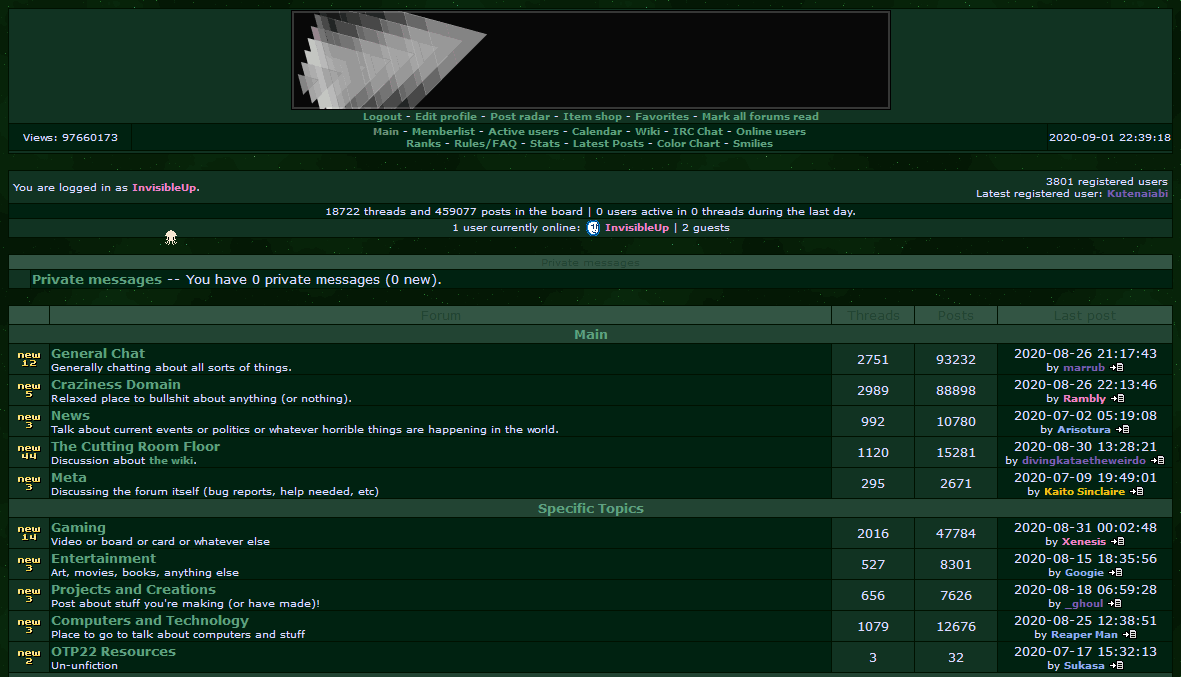
One of the most popular early applications for this were "message boards" or "forums", which were places you could visit with your web browser to make threads and post replies, just like Usenet. They never figured out the federation thing, though, but that was fine. You went to different message boards for different communities, and you frequented the ones with the people you liked the most. It was all low-stakes anyways, just hobby stuff like video games or cars or whatever.
Some other people played around with the concept a bit. Geocities and Angelfire provided small amounts of free website hosting if your ISP didn't do so, and gave you a way to browse other websites on the same service. (Neocities is the modern continuation of this idea.) Some ISPs figured out how to let you send and receive email through a web browser, which was cool, if a bit clunky. Neopets was an early social internet game that let you raise virtual pets. Uniquely, it also let you have your own personal page you could decorate however you wanted using HTML, and use that as a way to connect with other players. YouTube let you upload entire videos to your "channel", for free! I mean, if you ignore the little Vonage ad in the corner.
Social networking site like Friendster, MySpace, and Facebook were just the evolution of that idea, but with broader strokes. It was a website, that you could make your own page on, and communicate with other people. Facebook early on had a "profile" that listed your interests and personal information and such, and a "wall" that all your posts went to. Other people could post to your wall, and you could post to others walls. All of these were collected in a central "news feed", where you could view everyone's updates.
Entrusting the keys
People liked Facebook and Twitter and such as a concept. They invited their friends over to "poke" at each other and share recent photos and such. It was super easy to set up; all you needed was an email address and then you were good to go. Like AOL, but you could use any ISP.
Additionally, Twitter and Facebook and all that embraced Web 2.0. You could pipe data in and out of the services, so it didn't really matter if some people were on one service or the other. You (or more likely whoever produced the content) could write a simple cross-posting script. For example, WordPress, a blogging platform, was able to generate RSS feeds and tags and indexes automatically. From there, it was super easy to write, say, a Twitter bot that tweeted out whenever a new post was made. Or if you preferred an RSS reader like Google Reader, you could follow Twitter users via RSS. You could have all the content in whatever format you wanted! ...unless it was a Geocities page, but whatever, those are old hat.
But, if we're talking about individual people, is anyone really going to go through that trouble? Twitter doesn't have walls, and Facebook doesn't have hashtags. And I can't reply to Twitter users from Facebook or vice versa. And any third-party thing would have no chance at gaining users now; everyone was already committed to their preferred platforms. So hey, I'll join the network. Why not.
The inherent problem in all of this was that, because of the allure of a one-stop friend shop, we entrusted the space we share with them to for-profit corporations. We gave them the keys to power over our social lives. And the things were were doing on social media were more than "oh dude, look at this pic I snapped at the party last night!", people were having increasingly serious discussions here on politics and personal health and private matters. Granted, it's not like Geocities or AOL or whoever were better than the NYC slumlords, you still had strict limits, you didn't have total freedom. But they never had a monopoly on the market.
Remember the mall example, where they pushed different demographics towards different parts of the site? That's exactly what social media sites did, by promoting friends and groups to "follow". And they had incentive too; these were corporations, not no-name "bulletin board services" following a standard. They needed to make a profit, and target advertising was a very interesting idea. Imagine only getting ads based on your interests! It's cheaper for the advertisers, it's less annoying for the consumer, it's an absolute win. ...oh, wait, those Web 2.0 APIs let people filter out ads? Yeah, we should probably stop supporting those.
So, it's no surprise that social media sites began leveraging their power. Facebook in particular has been the brunt of this, as political advertising, the "Trending" sidebar, etc. have all been bent in Facebook's interests. (In the most extreme example, Facebook seems to be promoting Holocaust denial conspiracy theories for some reason.) Additionally, there's discussions now about "fake news", whether online platforms have the responsibility to only allow the truth, as to who determines the truth. We've placed so, so much political power in Facebook when we placed all of our social power in their hands. And with that power, they seem to be promoting right-wing interests. The Wall Street Journal has an old project, Blue Feed, Red Feed, that visually shows this difference for a few different political topics.
Likewise, YouTube's main focus is increasing ad revenue, which inherently involves making the site more enticing, more addicting. The "algorithm" that dictates what's in your recommended views has no problem shifting you to greater and greater extremes, in an effort to squeeze more and more free time out of you. Mozilla, the creators of Firefox, made a site called TheirTube that lets you view YouTube's front page from the perspective of a few stock personality types, like "Prepper", or "Climate Denier". YouTube's algorithm does whatever is required to make you dependent on them, whatever is needed to be your only source of truth on what's going to happen, what is happening.
This malicious interdependence is nothing new; YouTube user 'Quinton Reviews' made a very good video about how television channels abused the 2012 "apocalypse" for personal gain. (Please ignore the NordVPN advertisement; they're not worth your money. Alternatively, install SponsorBlock.) Channels like the History Channel aired documentaries that claimed to predict the end ot the world, "televangelists" claimed to give you eternal salvation if you tuned in, and they all made bank on revenue.
It's just concerning now, that most people's primary source of entertainment, conversation, and personal connection has every motivation to breed dependence and addiction, to milk ad revenue out of you, to change your politics to suit their needs. I'll admit I sound like a bit of a conspiracy theorist at this point, but this does happen. The Alt-Right Playbook: How to Radicalize a Normie does an excellent job at explaining how groups, in this case alt-right groups, breed dependence and change political views.
The more subtle point I want to get at here is that what's happening online is just the natural extension of what was happening offline. We don't control our living spaces anymore. We have no say in our communities. The mysterious higher-ups with no interest in your well-being do. If Twitter rearranges some buttons on their website, if YouTube removes an useful feature, you're out of luck. They're too powerful. You can't fight them. You can't even boycott them, at this point. Not even official government communication (or whatever Trump's tweets qualify as) is safe.
Quick Aside: "The Filter Bubble"
One of the common complaints about modern social media is the "filter bubble". The whole pushing-people-into-their-own-corners things I was literally just talking about. It's very important that I state that filtering is not an issue, and in fact is often a good thing. LGBT people, for instance, want to communicate with other LGBT people, and really want to exclude homo/trans/etc-phobic people from their primary social space. And, more broadly, people generally like hanging out with their friends, not random strangers.
What's important is that we allow a time and place for cross-group interactions to occur. The mall can only filter its shoppers so much, as everyone goes to the same food court in the end. You can always not go there, or go there with the support of trusted friends, because it's a separate but accessible space. And besides, it's the food court, you're there to eat food, not have deep emotional discussions.
Filter bubbles are generally disliked because they make that common space intentionally difficult to access by only suggesting videos that will get the viewer emotionally charged and invested. YouTube's algorithm is never going to show a right-winger a PhilosophyTube or ContraPoints video, and it's usually not going to show a left-winger Jordan Peterson and Ben Shapiro. (I say usually because the algorithm seems really eager to promote that stuff if it gets the slightest hint you're interested, I've found, while you have to actively search out for the "breadtube" sorts of videos. Possibly because the right wing tends to be a lot better at getting people emotionally invested with radical conspiracies or cults of personality, despite the facts-don't-care-about-your-feelings talk. Conversely, the left is more about lengthy, academic videos with visual spectacle. Something you'd watch on your lunch break before moving on with your life.)
The solution here isn't to, ex: shove transphobic content down a questioning trans woman's throat, but to have non-controversial, relaxed common areas. Like the food court, or videos about hobbies, or just a "popular" feed. You go there to eat food, maybe meet a new person if you wanna. It's a low-stakes, low-pressure place to expose yourself to more people and more viewpoints. Perhaps you'll find someone you really like spending time with, and invite them to your comfort zone.
Part 4: The Small Internet
Okay, let's step back a bit. Long story short, everyone uses Twitter, Facebook, etc. now. That's where all the people are, that's where all the data is, you can't buck that trend alone. It's very, very easy to get set up on these websites, very much by design. Significantly easier than making a homepage ever was.
Let's talk about the internet, as a medium. Your web browser makes a connection to some web server, and you get data back. This web server can be any web server, big or small. So, why not try and re-create the big servers with more personal control? It would be like setting up town squares where small communities meet, but still attached to the greater world.

That's the thought behind the Mastodon project. It's an open source recreation of Twitter, with some additional features. You can caption your images, you can spoiler tag posts, you can have some but not all posts be private, you can have long posts, your server admin can add custom emoji, etc. etc. And because it's open source, it can be installed on any web server, big or small. Additionally, each server can federate with each other, so that they all merge into an interconnected "Fediverse", just like the FidoNets and the FreeNodes of the past.
This is a powerful concept. Mastodon (by default) is very much like Twitter, but no single group controls the entire network. You can choose any server admin you want, and the servers are almost always small enough that you can directly communicate with them if you have a problem. Admins control who can federate (sync posts) with whatever servers they want, block others, etc. (For example, most instances I'm aware of block "Gab", an alt-right Fediverse server.) It's not quite as easy as Twitter, yes, but it's decentralized. And that's the most important part.
By embracing the old approach to Web 2.0 APIs and fixing their flaws, we can decentralize the web and remove dependence on any one source of power over our online lives. Mastodon internally uses a standardized protocol called ActivityPub to sync between servers, which allows for many implementations of the server software. In practice right now there's about two independent ones (Mastodon and Pleroma), all with their own forks. The point is that no single company is in charge of the spec, there's no feasible way to lock down features without breaking the network, and features of the network rarely if ever go away. Protocol changes need to either be backwards compatible, or be adopted via consensus across almost all server administrators. Another bonus: targeted advertising and the issues that brings would be virtually impossible to implement.
This isn't new. This is how the internet has always worked. This is how BBSes and Usernet and the World Wide Web work. Email is another fantastic example. You can sign up for email on any provider, and it gets sent via a standard protocol (IMAP and SMTP, usually) to the proper server as needed. Likewise, web browsers all display the same, standard HTML and CSS pages. The standards aren't perfect, of course, but it's not impossible to write a new one, as the ActivityPub people have done. As another recent example, the Gemini Project is attempting to create a brand new protocol for delivering text documents, basically like a polished up and secure version of Gopher.
The only issue with this approach becomes the technical ceiling. Mastodon is usable enough as a complete replacement for Twitter, even if it's a bit of an adjustment. But YouTube? Facebook? Reddit? Discord? Those don't have good, modern replacements. At best, you have protocols that haven't been actively used since the 90s, and are missing many quality of life features. Additionally, setting up a decentralized server tends to be a pain, involving arcane Linux commandline-fu and lots of config file tweaking. (I know, I've done it myself.)
A good, decentralized, small internet must be easy to use, easy to set up new servers, and easy to create content for. Unfortunately, there's still a lot of progress yet to be made. Good news, though, is that server hardware has never been cheaper. You can go to DigitalOcean or Vultr or any number of other providers and get your own, always online Linux server with a domain name for only a few bucks a month. This is a luxury we simply do not have offline, where every parcel of land is already owned by somebody, where you need hundreds of dollars a month to simply exist, let alone live a dignified life. Let's use this cheap internet space to our advantage, and re-decentralize the internet. Maybe once we do that, we can repair the bonds in our physical communities as well.
Also, I feel like I should squeeze in the "small internet" Gopher phlog series by ~spring, which is idealistic as heck but a really interesting read nonetheless.
Part 5: How to Help Decentralize the Web Today
If you've made it this far, I assume we're on the same page. Let's talk about actionable items to take the internet away from big corporations and place it back in your hands.
Join the Fediverse
An easy way to dip your toes into the idea is to create a Mastodon account. Here's a webpage that can help you choose a server. Don't stress too much about the choice; it's very easy to pack up and move at any time. Think of it like an email address, but for Twitter-like posts instead of emails.
When you're on a server, it's a good idea to try and get to know the people on the same server. This is much easier compared to Twitter, as there's simply less people on any single server. You can also check out and subscribe to anyone on the greater Fediverse. My account is invis@glaceon.social, if you want to follow me.
Use RSS to Follow People
RSS is a document type that allows you to "subscribe" to any blog or "feed". It's not nearly as popular as it was about a decade ago (thanks, Google Reader), but it's still very much alive and kicking. Using RSS instead of Twitter, Facebook, etc. to subscribe the content gives you one place to view things on the internet that you care about that you are completely in control of.
For most services, you can use RSS-Bridge to create RSS feeds from, ex: YouTube, Twitter, Facebook, etc. Stuff like webcomics and blogs will usually have RSS feeds as well.
To use RSS, you'll need an RSS reader. There aren't nearly as many nice options as there were a decade ago, but here's a list of ones I like:
- Various Firefox addons
- Feedbro for Chrome
- NewsBlur (web service)
- The Old Reader (web service)
- Akregator (Linux app)
This isn't an exhaustive list, but they're good places to start. Remember that you can export your feed list and move to another reader at any time. Oh, by the way, my website has an RSS feed if you're interested at https://invisibleup.com/atom.xml.
Make a Homepage
If you want to have your own creative canvas on the web, consider making a homepage! Right now the best (and really, only good free) webhost is Neocities, which comes with a way to discover new sites and a tutorial on how to make your own homepage. This isn't super easy, as it involves writing in the HyperText Markup Language, but it's very rewarding. Check my links page if you're looking for inspiration.
Become a Server Administrator
This is unfortunately quite difficult at the moment, but it's an option worth considering if you're willing to put in the time and resources. You can not only host your homepage from here, but also a Mastodon server, a personal RSS reader, and lots more.
There's a very good website, runyourown.social, that walks through the social hurdles of setting up your own community server. If you need technical help, I'd highly advise asking your current Mastodon server administrator for help, as well as browsing /r/selfhosted. It's also possible to use a hosted solution like masto.host, if you are okay with the limitations that provides.
If you need a server provider, you can use my DigitalOcean referral link if you want. You don't have to. But I'd appreciate it.
Part 6: Ideas to Help Decentralize the Internet Tomorrow
If we want to continue taking back the internet, we'll need some help. Here's a list of projects that I personally feel are important, but I absolutely do not have the time or energy to contribute to. These are merely suggestions, not demands.
Easier server admin tools
Currently, setting up a web server is rather difficult. Yes, things like Docker and Puppet and all that exist, but those require a certain level of technical expertise that the vast majority of people simply do not have.
I would imagine a simple, web-based console would be most effective here. You could flash it to a Raspberry Pi or load it on a VPS, log in, and start setting up with absolutely no command-line knowledge. You could install "apps" (including both web services and other protocols like XMPP, Gemini, FTP, etc.), manage users, and route apps to different URLs, all from a simple admin console.
Easier user / login management
When administering Park City, I've definitely noticed issues when setting up new services for multiple people. Most self-hosted web apps assume that there's only a handful of users at most, and that there is an extremely high degree of trust. This simply does not scale. (I made a tweet thread complaning about this a while back.)
What needs to exist is a easy-to-set-up OAuth provider that every web app you self-host supports. This provider should work with passwords, or preferably client-side TLS certificates (which would allow for passwordless login), allow password resets via email, possibly two-factor authentication, all the normal things. As far as I'm aware, this doesn't exist, and most people want you to use a service like Google or Twitter for authentication, which defeats a lot of the point in my opinion. And all self-hosted web apps need to support OAuth as well, for this to be effective.
Easier self-hosted email
It is technically possible to self-host email, but the overwhelming attitude towards doing so is "please don't". There's a lot of configuration and setup required, and a large portion of this is due to spambots, spam filters, etc. Self hosted email is generally not trusted by default.
Self-hosted email needs to be easier and more accessible without creating more global email spam. I have no idea what the solution is for this. For Park City I just gave up and used Migadu for webmail hosting. For a while I had no complaints, but now they're requiring payment for the service, and I'm not sure if that's worth the cost.
Different web document types?
Everything on the Internet today is HTML5. This spans everything from simple documents, like what you're reading right now, to incredibly complicated web applications like Twitter. This feels wrong, and seems to be trending towards a browser monoculture where only Firefox's Gecko and Chrome's Blink engines can render all web content.
I would suggest splitting things into a very clear split between "document" and "application". An idea I had was to build on SVG for applications, as that supports Javascript / CSS and seems to be significantly better suited for what most web applications are doing anyways. That said, SVG as it is right now doesn't support scrollable sections, barely supports text reflow, doesn't handle scaling without resizing very easily, and is a pain to work with in general. It would be nice to add a few features to SVG (that can be shimmed with JS) to make it more suitable for rendering applications, instead of continuing to shove everything into HTML and CSS.
With that done, the HTML and CSS specs can be slimmed down or possibly even replaced with a simpler alternative, allowing for simpler, more diverse web browsers for the vast majority of web content. Additionally, SVG is less complex to implement as there's less layout and flow considerations to worry about, so making web-app browsers might be easier as well.
This, obviously, is a pie-in-the-sky idea. But I've seen it proposed before. This article by Tom MacWright gets into a lot of detail and speculation about this concept.
Server hosting from home
It would be incredibly nice to be able to just plug in a Raspberry Pi, give it a domain name, and have that just work for hosting all sorts of internet content. Unfortunately, that's not usually possible.
A lot of this is due to IPv4 address exhaustion. Because of the limited number of addresses, they're almost never assigned to each residential device, but instead to larger groups. IPv6 adoption might solve this by giving each device a single IPv6 address, eliminating the need for port forwarding, etc. (Maybe. I haven't looked into this much.)
Additionally, IP addresses tend to be reassigned from time to time. If there were a way for a web server to automatically sync with and update the corresponding DNS server on an IP address change, that would eliminate that problem almost entirely.
It's possible there's more problems (or solutions) here that I haven't researched.
Part 7: Conclusion
Congratulations on surviving this incredibly long article. If you didn't, the punchline was that it really, really matters who we entrust with our primary social spaces. Instead of entrusting the world to one corporation, one point of failure, one basket if you will, we spread it out. We let communities run themselves, but keep them federated with the larger groups they inhabit in low-stakes "food court" settings. We keep the cost of moving between "third places" very low, so that abusive community leaders don't force anyone to stay.
Also, worth mentioning, those points above apply to physical social spaces as well. Preferably we'd like to be in control of our physical social spaces, so no capitalist can buy the place out, hollow its soul out, and sell eight dollar Uncrustables to tourists. Our communities should be reflections of the people who inhabit them, not perscribed aesthetics from the suits.
But we should start with the internet, I feel, because it's much easier to start there. You can paint the space any color you want and dress yourself as any avatar for no additional cost. Having a easy, versatile community space like that is vital, and is the first step towards doing these sorts of things offline, where the stakes are a bit higher.